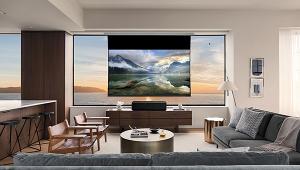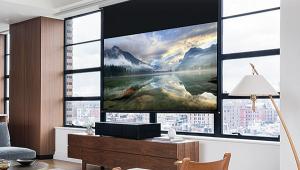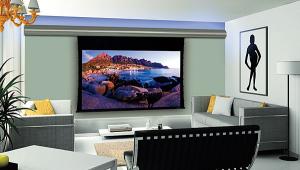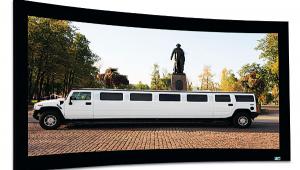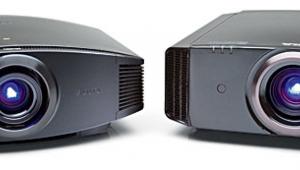Choosing a Front Projection Screen
A front projector setup is really a projection system. The screen is an integral and critical part of every projection system—front or rear—and any attempt at a makeshift substitute simply won't get the best out of your projector.
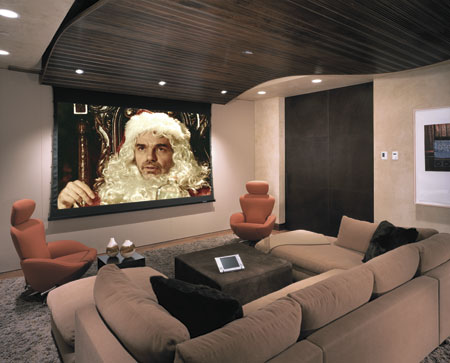
Lights Out?
A video projector and screen are designed to work best in the darkest room you can manage. Yes, there are new screens on the market (from manufacturers such as Sony, Planar, and DNP) designed specifically to optimize viewing in a room with at least some ambient room light (though preferably not shining directly on the screen). They can work well if you really need them, but in our experience any projector will produce its best, most films-like images in a completely darkened room.
Just remember this basic fact: A projector does not project black. Black is the absence of light. Any light falling on the screen from any source other than the projector itself will raise the absolute black level of the picture and reduce the contrast.
The Big Picture
Two things will dominate all others as you choose the screen you will need: your projector and the size of the image you want. You also need to decide on an aspect ratio for your screen—the ratio of the screen's width to its height. Today's most popular and practical shape is 16:9—the aspect ratio of HDTV broadcasts and Blu-ray and HD DVD discs.
When you order a projection screen, be sure to indicate whether you're specifying the screen's size by its width or diagonal measurement. Unlike one-piece televisions (where the diagonal gives the bigger number!), projection folks usually (but not always) speak width rather than diagonal.
Light Up My Life
Many enthusiasts want as big a screen as they can manage. But the bigger the screen the dimmer the image. As a picture dims, it also looses "punch" and can look increasingly flat and two-dimensional. In our experience, screens with a width of 80"-87" provide the best overall results, depending on the projector. The smaller sizes produce the most strikingly beautiful images, but less immersion. But because the black levels drop along with the brightness as the screen size increases, smaller screens are at their best with projectors that offer the deepest blacks.
Apart from size, the other important screen characteristic is known as gain. It can be nearly as significant in determining the brightness of the image as size. A screen is a passive device and can't literally amplify anything. It produces "gain" by focusing the light toward the center of the viewing area, resulting in a brighter image on- or slightly off-axis, but a dimmer image as you move further to the sides. High gain screens can also have hot spots; that is, they look obviously brighter in the center than at the sides. The higher the gain, the more pronounced the hot spot.
The screen material determines the overall reflective characteristics of the screen, including its gain:
- High gain (over 2.0 ): High gain screens can be useful if you insist on a very large screen, or have a projector with a very low light output. While some users swear by such screens, we generally don't recommend them. They are skewed toward brighter images, often sacrificing other important characteristics like color purity, brightness uniformity, and resolution.
- Medium gain (1.1-2.0): A modest screen gain can be useful. The most common screen of this type, and the type many of us favor, has a gain of about 1.3. Such screens are made by Stewart Filmscreen (Studiotek 130), Da-Lite (Cinema Vision), and others. And a gain of 1.3 is about as high as you should go if you want to avoid significant off-axis brightness, noticeable hot-spotting, or other aberrations.
- Low gain (below 1.1): Many so-called "matte white" screens are specified to have a "gain" of approximately 1.0. Such a screen reflects light evenly in all directions over most of the area in front of it, with little tendency to concentrate its reflective output toward the center of the viewing area. It will provide a roughly the same brightness at all seating positions, even far off-axis.
Most screens in this category are white, but there's a special category here represented by the Stewart FireHawk. This screen is gray, and designed to provide richer blacks while maintaining a modest gain. It's noticeably dimmer off-axis than on, but this is intentional. It minimizes reflections from nearby walls. The FireHawk was very popular a few years ago when digital projectors had inherently poor blacks. But while still available, it's less relevant with today's projectors. In our opinion most of today's premier projectors produce better results on a standard white screen with a gain of about 1.3, like Stewart's own Studiotek 130.
Some (but not all) of these low gain screens look gray in normal room lighting, and often have a gain even lower than 1.0. But because of the characteristics of the eye, white picture details look white on them.
The point of a reduced gain screen is to produce darker blacks. The bad news, of course, is that the rest of the image is dimmed along with the blacks. But some projectors have enough output to make good use of such a screen.
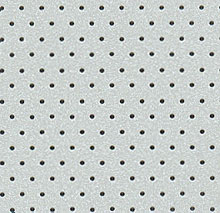 To Perf or Not to Perf
To Perf or Not to Perf
Most screens are are essentially opaque to sound. But you can also choose screens designed to be acoustically transparent. Such screens use either a woven material or millions of tiny "micro-perforations," which allow you to position your center channel speaker (or all your front speakers, if the screen is large enough) behind them.
It's certainly an advantage to have voices, for example, come from the screen area rather than above or below it. But such screens do have limitations. Some light passes through them, producing a lower gain and a dimmer image. The perforations can also reduce resolution, or even cause moire patterns as the perforations interract with the image's pixel structure. For these reasons we don't use acoustically transparent screens when evaluating video projectors. But they have their proponents.
This and That
The most common, and affordable, screen type is the fixed-frame, non-retractible style designed to be mounted either on a wall or on a stand. It may also be hung from the ceiling, either near a wall or even part way out into a room.
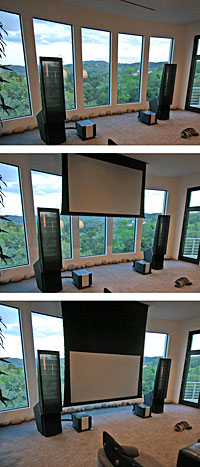 A retractable screen gets out of the way when not in use, a feature everyone appreciates, including audiophiles who plan to use the home theater system for both movies and music. (It also moves the relatively fragile screen material, which usually cannot be washed to remove marks, out of harm's way.) Most such screens are powered, much more expensive than their fixed-screen cousins, and relatively heavy. Professional help is recommended when mounting any screen, but particularly this type.
A retractable screen gets out of the way when not in use, a feature everyone appreciates, including audiophiles who plan to use the home theater system for both movies and music. (It also moves the relatively fragile screen material, which usually cannot be washed to remove marks, out of harm's way.) Most such screens are powered, much more expensive than their fixed-screen cousins, and relatively heavy. Professional help is recommended when mounting any screen, but particularly this type.
Just be certain when you order a retractable screen that the amount of black "drop" material at the top of the screen is sufficient to bring the active image area down to an appropriate height for viewing. And don't forget to allow sufficient space under the screen for your center channel speaker; if it's a conventional, horizontal center channel design you'll want to keep it at least a foot off the floor.
There are also screens with adjustable masking, screens with a wider aspect ratio for displaying 2.35:1 widescreen films without black bars, screens designed for rear projection applications, and even screens that you can inflate and use to watch films in the back yard. nBut these are expensive, specialized solutions to problems that the video projector newcomer won't need to deal with. At least not until he or she starts planning upgrades!
Recommendations
Different installations will have different requirements, but for most current home theater projectors you'll avoid serious problems if you stick with a screen width of 80 to 87-inches, with smaller screens giving you extra reserve to allow for lamp wear. If the projector has good blacks, we recommend a screen with modest gain (1.3 or so), particularly at the higher end of that size range. Very bright projectors may, however, provide better results with a screen gain of 1.0—or even a bit lower.
If you insist on a larger screen, be aware of the tradeoffs involved. The optimum seating distance differs with screen size. You can get the same impact and picture quality from a smaller screen as you will seated further away from a larger one. The only advantage to the larger screen in this case is that it will provide more impact to multiple rows of seating. The smaller screen will also require a less bright—and very possibly less expensive—projector.
If all this sounds complicated, you can always hire a custom installer to do the heavy lifting for you (literally and figuratively). But it will all be worth it in the end, when you get the best picture your projector can provide.
